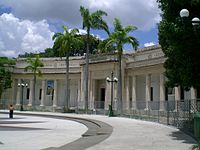
Photo from wikipedia
Chemical control of Aedes aegypti continues to be an indispensable alternative to preventing dengue, Zika, and chikungunya outbreaks. The Havana Zoological Garden requires constant vigilance because its special characteristics help… Click to show full abstract
Chemical control of Aedes aegypti continues to be an indispensable alternative to preventing dengue, Zika, and chikungunya outbreaks. The Havana Zoological Garden requires constant vigilance because its special characteristics help in the spread of the causal agents of diseases transmitted by mosquitoes, which put the health of visitors at risk. The goals of this study were to determine the level of susceptibility and insecticide resistance mechanisms in the Ae. aegypti population. Temephos susceptibility in larvae was evaluated with bioassays using the World Health Organization's methodology, and susceptibility of adult mosquitoes was determined by the impregnated bottle bioassay, recommended by the Centers for Disease Control and Prevention. Resistance mechanisms were determined with biochemical assays. Mosquito larvae from the Havana Zoo were found resistant to temephos, which was associated with the activity of the enzymes α- and β-esterases and mixed function oxidases but not glutathione-S-transferase. Adult mosquitoes were susceptible to pyrethroid (lambda-cyhalothrin, deltamethrin, and cypermethrin), organophosphate (chlorpyrifos), and carbamate (bendiocarb). Temephos resistance detected in the mosquito population from the Havana Zoo is an alert for the Vector Control Program, which must take measures to manage their resistance, relying on the surveillance carried out by Cuba's medical entomology laboratories.
Journal Title: Journal of the American Mosquito Control Association
Year Published: 2022
Link to full text (if available)
Share on Social Media: Sign Up to like & get
recommendations!